
Chemical Biology & Biochemistry Laboratory Using Genetic Code Expansion Manual
- Subject:
- Biology
- Natural Science
- Material Type:
- Textbook
- Provider:
- Oregon State University
- Author:
- Kari van Zee
- Kelsey Kean
- Ryan Mehl
- Date Added:
- 10/26/2023

Chemical Biology & Biochemistry Laboratory Using Genetic Code Expansion Manual
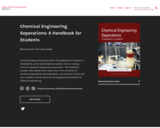
Chemical Engineering Separations: A Handbook for Students is intended for use by undergraduate students who are taking a course in chemical engineering separations. The handbook assumes that students have taken one or two semesters of chemical engineering thermodynamics, one semester of heat and mass transfer, and one semester of computational methods for chemical engineering.
Table of Contents:
1. Performance Metrics for Separation Processes
2. Mass Transfer in Gas-liquid Systems
3. Liquid-liquid Extraction
4. Absorption and Stripping
5. Distillation
6. Membranes
7. Sorption and Chromatography
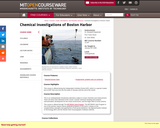
Laboratory or field work in atmospheric science and oceanography. To be arranged with department faculty. Consult with department Education Office. This is an undergraduate introductory laboratory subject in ocean chemistry and measurement. There are three main elements to the course: oceanic chemical sampling and analysis, instrumentation development for the ocean environment, and the larger field of ocean science. This course is offered as part of the MIT/WHOI Joint Program in Oceanography/Applied Ocean Science and Engineering.
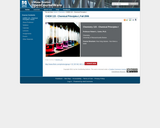
Introduction to the fundamental principles of chemistry including atomic structure, stoichiometry, the periodic table of the elements, chemical bonding, molecular structure, and states of matter based on kinetic theory. This course is intended for majors in any of the sciences, including pre-dental, pre-medical, and pre-engineering students
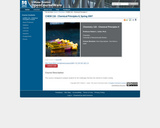
This course is designed to prepare students for the challenges that face the chemist in modern society.
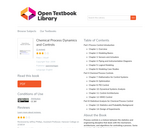
Process controls is a mixture between the statistics and engineering discipline that deals with the mechanism, architectures, and algorithms for controlling a process. Some examples of controlled processes are:
•Controlling the temperature of a water stream by controlling the amount of steam added to the shell of a heat exchanger.
•Operating a jacketed reactor isothermally by controlling the mixture of cold water and steam that flows through the jacket of a jacketed reactor.
•Maintaining a set ratio of reactants to be added to a reactor by controlling their flow rates.
•Controlling the height of fluid in a tank to ensure that it does not overflow.
Table of Contents
Part I Process Control Introduction
Chapter 1: Overview
Chapter 2: Modeling Basics
Chapter 3: Sensors and Actuators
Chapter 4: Piping and Instrumentation Diagrams
Chapter 5: Logical Modeling
Chapter 6: Modeling Case Studies
Part II Chemical Process Controls
Chapter 7: Mathematics for Control Systems
Chapter 8: Optimization
Chapter 9: PID Control
Chapter 10: Dynamical Systems Analysis
Chapter 11: Control Architectures
Chapter 12: MIMO Control
Part III Statistical Analysis for Chemical Process Control
Chapter 13: Statistics and Probability Background
Chapter 14: Design of Experiments

This course uses an open textbook University of Michigan Chemical Engineering Process Dynamics and Controls. The articles in the open textbook (wikibook) are all written by teams of 3-4 senior chemical engineering students, and are peer-reviewed by other members of the class. Using this approach, the faculty and Graduate Student Instructors (GSIs) teaching the course act as managing editors, selecting broad threads for the text and suggesting references. In contrast to other courses, the students take an active role in their education by selecting which material in their assigned section is most useful and decide on the presentation approach. Furthermore, students create example problems that they present in poster sessions during class to help the other students master the material.
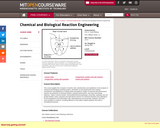
Introduces the design of chemical reactors via synthesis of chemical kinetics, transport phenomena, and mass and energy balances. Topics: reaction mechanisms and chemical/biochemical pathways; transition-state theory; batch, plug flow and well-stirred reactors; heterogeneous and enzymatic catalysis; heat and mass transport in reactors, including diffusion to and within catalyst particles and cells or immobilized enzymes.
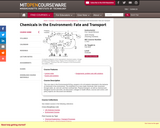
For Institute students in all departments interested in the behavior of chemicals in the environment (see ESD listings for other subjects). Emphasis on man-made chemicals, their movement through water, air, soil, and their eventual fate. Physical transport, as well as chemical and biological sources and sinks, are discussed. Linkages to health effects, sources and control, and policy aspects.
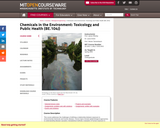
This course addresses the challenges of defining a relationship between exposure to environmental chemicals and human disease. Course topics include epidemiological approaches to understanding disease causation; biostatistical methods; evaluation of human exposure to chemicals, and their internal distribution, metabolism, reactions with cellular components, and biological effects; and qualitative and quantitative health risk assessment methods used in the U.S. as bases for regulatory decision-making. Throughout the term, students consider case studies of local and national interest.

Chemistry is designed to meet the scope and sequence requirements of the two-semester general chemistry course. The textbook provides an important opportunity for students to learn the core concepts of chemistry and understand how those concepts apply to their lives and the world around them. The book also includes a number of innovative features, including interactive exercises and real-world applications, designed to enhance student learning.
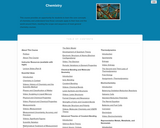
This course provides an opportunity for students to learn the core concepts of chemistry and understand how those concepts apply to their lives and the world around them, meeting the scope and sequence of most general chemistry courses.

Chemistry: Atoms First is a peer-reviewed, openly licensed introductory textbook produced through a collaborative publishing partnership between OpenStax and the University of Connecticut and UConn Undergraduate Student Government Association.
This title is an adaptation of the OpenStax Chemistry text and covers scope and sequence requirements of the two-semester general chemistry course. Reordered to fit an atoms first approach, this title introduces atomic and molecular structure much earlier than the traditional approach, delaying the introduction of more abstract material so students have time to acclimate to the study of chemistry. Chemistry: Atoms First also provides a basis for understanding the application of quantitative principles to the chemistry that underlies the entire course.
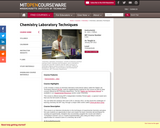
This course is an intensive introduction to the techniques of experimental chemistry and gives first year students an opportunity to learn and master the basic chemistry lab techniques for carrying out experiments. Students who successfully complete the course and obtain a "Competent Chemist" (CC) or "Expert Experimentalist" (EE) rating are likely to secure opportunities for research work in a chemistry lab at MIT. Acknowledgements The laboratory manual and materials for this course were prepared by Dr. Katherine J. Franz and Dr. Kevin M. Shea with the assistance of Professors Rick L. Danheiser and Timothy M. Swager. Materials have been revised by Dr. J. Haseltine, Dr. Kevin M. Shea, Dr. Sarah A. Tabacco, Dr. Kimberly L. Berkowski, Anne M. (Gorham) Rachupka, and Dr. John J. Dolhun. WARNING NOTICE The experiments described in these materials are potentially hazardous and require a high level of safety training, special facilities and equipment, and supervision by appropriate individuals. You bear the sole responsibility, liability, and risk for the implementation of such safety procedures and measures. MIT shall have no responsibility, liability, or risk for the content or implementation of any of the material presented. Legal Notice
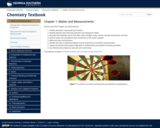
Table of Contents:
1. Matter and Measurements
2. Atoms, Molecules and Ions
3. Composition of Substances and Solutions
4. Stoichiometry of Chemical Reactions
5. Thermochemistry
6. Gases
7. Chemical Bonding and Molecular Geometry
8. Liquids, Solids, and Modern Materials
9. Solutions and Colligative Properties
10. Kinetics
11. Chemical Equilibria and Applications
12. Thermodynamics
13. Electrochemistry
14. Appendices
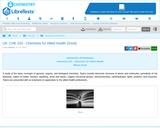
University of Kentucky
Chemistry 103 – Chemistry for Allied Health
A study of the basic concepts of general, organic, and biological chemistry. Topics include electronic structure of atoms and molecules, periodicity of the elements, states of matter, kinetics, equilibria, acids and bases, organic functional groups, stereochemistry, carbohydrates, lipids, proteins, and enzymes. Topics are presented with an emphasis on application to the allied health professions.
Chapter 1: Measurements and Problem-Solving
1.1: Measurements Matter
1.2: Significant Figures
1.3: Scientific Dimensional Analysis
1.4: Percentages
1.E: Measurements and Problem-Solving (Exercises)
Chapter 10: Nuclear and Chemical Reactions
10.1: Nuclear Radiation
10.2: Fission and Fusion
10.3: Half-Life
10.4: Physical and Chemical Changes
10.5: Chemical Equations
10.E: Nuclear and Chemical Reactions (Exercises)
Chapter 11: Properties of Reactions
11.1: Oxidation Numbers
11.2: The Nature of Oxidation and Reduction
11.3: Types of Inorganic Reactions
11.4: Entropy and Enthalpy
11.5: Spontaneous Reactions and Free Energy
11.6: Rates of Reactions
11.E: Properties of Reactions (Exercises)
Chapter 12: Organic Reactions
Organic reactions are chemical reactions involving organic compounds. The basic organic chemistry reaction types are addition reactions, elimination reactions, substitution reactions, pericyclic reactions, rearrangement reactions, photochemical reactions and redox reactions.
12.1: Organic Reactions
12.E: Organic Reactions (Exercises)
Chapter 13: Amino Acids and Proteins
Amino acids are molecules containing an amine group(NH2), a carboxylic acid group(R-C=O-OH) and a side-chain( usually denoted as R) that varies between different amino acids. They are particularly important in biochemistry, where the term usually refers to alpha-amino acids. Proteins are biochemical compounds consisting of one or more polypeptides typically folded into a globular or fibrous form in a biologically functional way.
13.1: Amino Acids
13.2: Peptides
13.3: Protein Structure
13.E: Amino Acids and Proteins (Exercises)
Chapter 14: Biological Molecules
Biomolecules include large macromolecules (or polyanions) such as proteins, carbohydrates, lipids, and nucleic acids, as well as small molecules such as primary metabolites, secondary metabolites, and natural products.
14.1: Enzymes
14.2: Lipids and Triglycerides
14.3: Phospholipids in Cell Membranes
14.E: Biological Molecules (Exercises)
Chapter 15: Metabolic Cycles
15.1: Glycolysis
15.2: The Citric Acid Cycle
15.3: Lactic Acid Fermentation
15.4: The Electron Transport Chain
15.E: Metabolic Cycles (Exercises)
9.2: Homeostasis
Chapter 2: Elements and Ions
2.1: Isotopes and Atomic Mass
2.2: Matter
2.3: Mole and Molar Mass
2.4: Electron Arrangements
2.5: Ion Formation
2.6: Ionic Compounds
2.E: Elements and Ions (Exercises)
Chapter 3: Compounds
3.1: Molecular Compounds
3.2: Straight-Chain Alkanes
3.E: Compounds (Exercises)
Chapter 4: Structure and Function
The three dimensional shape or configuration of a molecule is an important characteristic. This shape is dependent on the preferred spatial orientation of covalent bonds to atoms having two or more bonding partners.
4.1: Lewis Electron Dot Structures
4.2: Representing Structures
4.3: Electron Group Geometry
4.4: Functional Groups
4.E: Structure and Function (Exercises)
Chapter 5: Properties of Compounds
5.1: Isomers
5.2: Carbohydrate Structures
5.3: Polarity and Intermolecular Forces
5.4: Chromatography
5.E: Properties of Compounds (Exercises)
Chapter 6: Energy and Properties
6.1: Heat Flow
6.E: Energy and Properties (Exercises)
Chapter 7: Solids, Liquids, and Gases
7.1: States of Matter
7.2: State Changes and Energy
7.3: Kinetic-Molecular Theory
7.4: The Ideal Gas Equation
7.5: Aqueous Solutions
7.6: Colloids and Suspensions
7.7: Solubility
7.E: Solutions (Exercises)
Chapter 8: Properties of Solutions
8.1: Concentrations of Solutions
8.2: Chemical Equilibrium
8.3: Le Châtelier's Principle
8.4: Osmosis and Diffusion
8.5: Acid-Base Definitions
8.6: The pH Concept
8.E: Properties of Solutions (Exercises)
Chapter 9: Equilibrium Applications
9.1: Acid and Base Strength
9.2: Buffers
9.E: Equilibrium Applications (Exercises)
Back Matter
Index

People around the world are fascinated about the preparation of food for eating. There are countless cooking books, TV shows, celebrity chefs and kitchen gadgets that make cooking an enjoyable activity for everyone. The chemistry of cooking course seeks to understand the science behind our most popular meals by studying the behavior of atoms and molecules present in food. This book is intended to give students a basic understanding of the chemistry involved in cooking such as caramelization, Maillard reaction, acid-base reactions, catalysis, and fermentation. Students will be able to use chemistry language to describe the process of cooking, apply chemistry knowledge to solve questions related to food, and ultimately create their own recipes.
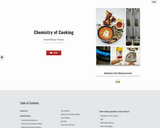
People around the world are fascinated about the preparation of food for eating. There are countless cooking books, TV shows, celebrity chefs and kitchen gadgets that make cooking an enjoyable activity for everyone. The chemistry of cooking course seeks to understand the science behind our most popular meals by studying the behavior of atoms and molecules present in food. This book is intended to give students a basic understanding of the chemistry involved in cooking such as caramelization, Maillard reaction, acid-base reactions, catalysis, and fermentation. Students will be able to use chemistry language to describe the process of cooking, apply chemistry knowledge to solve questions related to food, and ultimately create their own recipes.
Reviews available here: https://open.umn.edu/opentextbooks/textbooks/chemistry-of-cooking
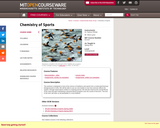
This seminar will focus on three sports: swimming, cycling and running. There will be two components to the seminar: classroom sessions and a "laboratory" in the form of a structured training program. The classroom component will introduce the students to the chemistry of their own biological system. With swimming, running and cycling as sample sports, students are encouraged to apply their knowledge to complete a triathlon shortly after the term.

Early Childhood Education / ECE-102 Child, Family and Community
Examines the developing child in a societal context focusing on the interrelationship of family, school, and community and emphasizing historical and socio cultural factors. The processes of socialization and identity development will be highlighted, showing the importance of respectful, reciprocal relationships that support and empower families.
Generic/Non-COC version (a derivative):
In Word: https://drive.google.com/file/d/1B4Y2EEp7HoECRBh_vXP3BCrg84QYOnjD/view?usp=sharing
In PDF: https://drive.google.com/file/d/11EETGrZW8__4DYWI_78e89Ru9S4OvM13/view?usp=sharing
The attribution for this derivative is: "Child, Family, and Community" by Rebecca Laff and Wendy Ruiz, College of the Canyons is licensed under CC BY 4.0 / A derivative from the original work
The COC version:
The Word version (to be easily edited) of the book can be found at https://drive.google.com/file/d/13xMpfZloGnrZyPQVOHvSIYwVYsH_24gX/view?usp=sharing
The PDF version of the book can be found at https://drive.google.com/file/d/1jOkejB_wKLZYpDaaUJpfRceQ01LA9Fth/view?usp=sharing